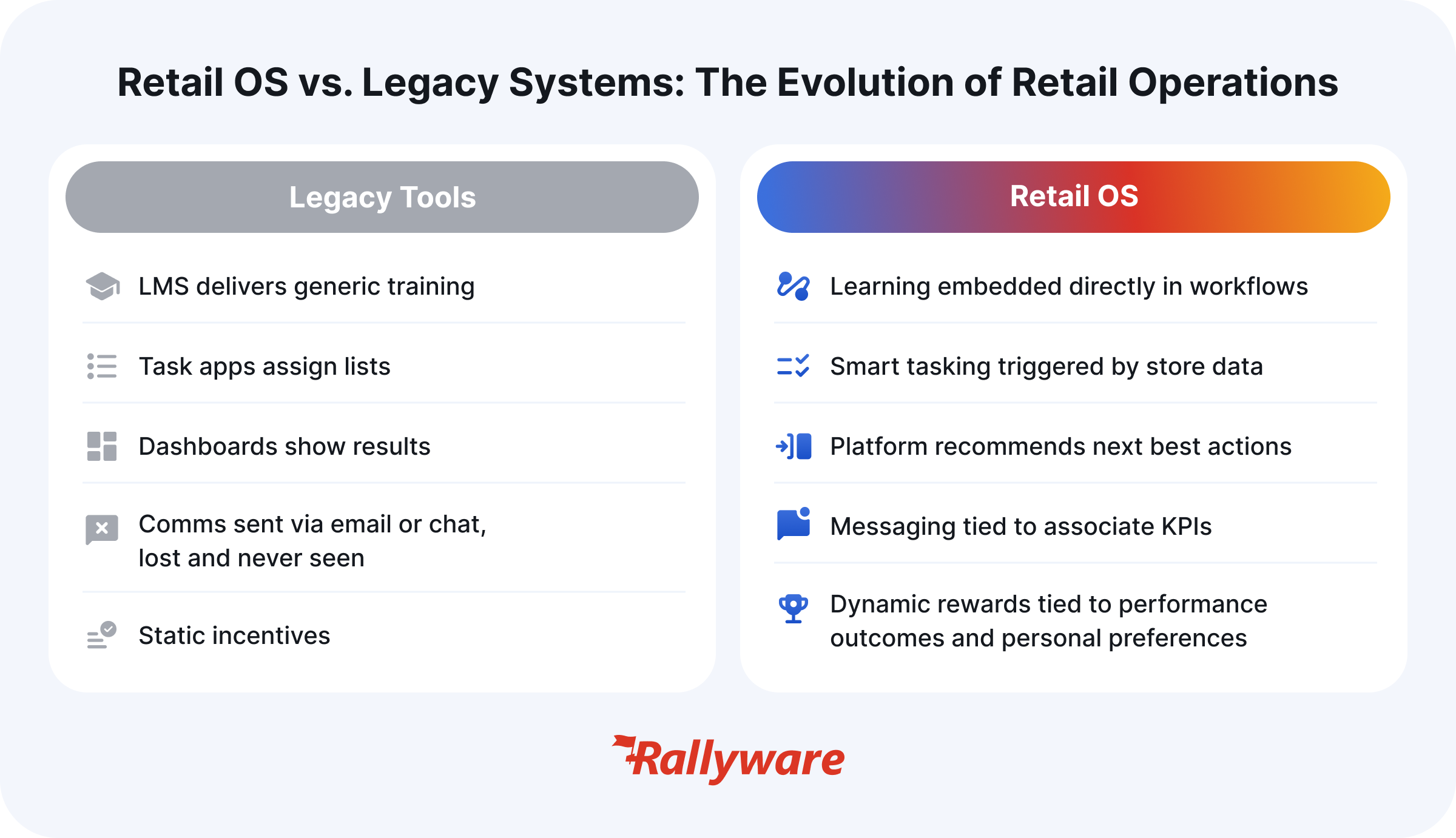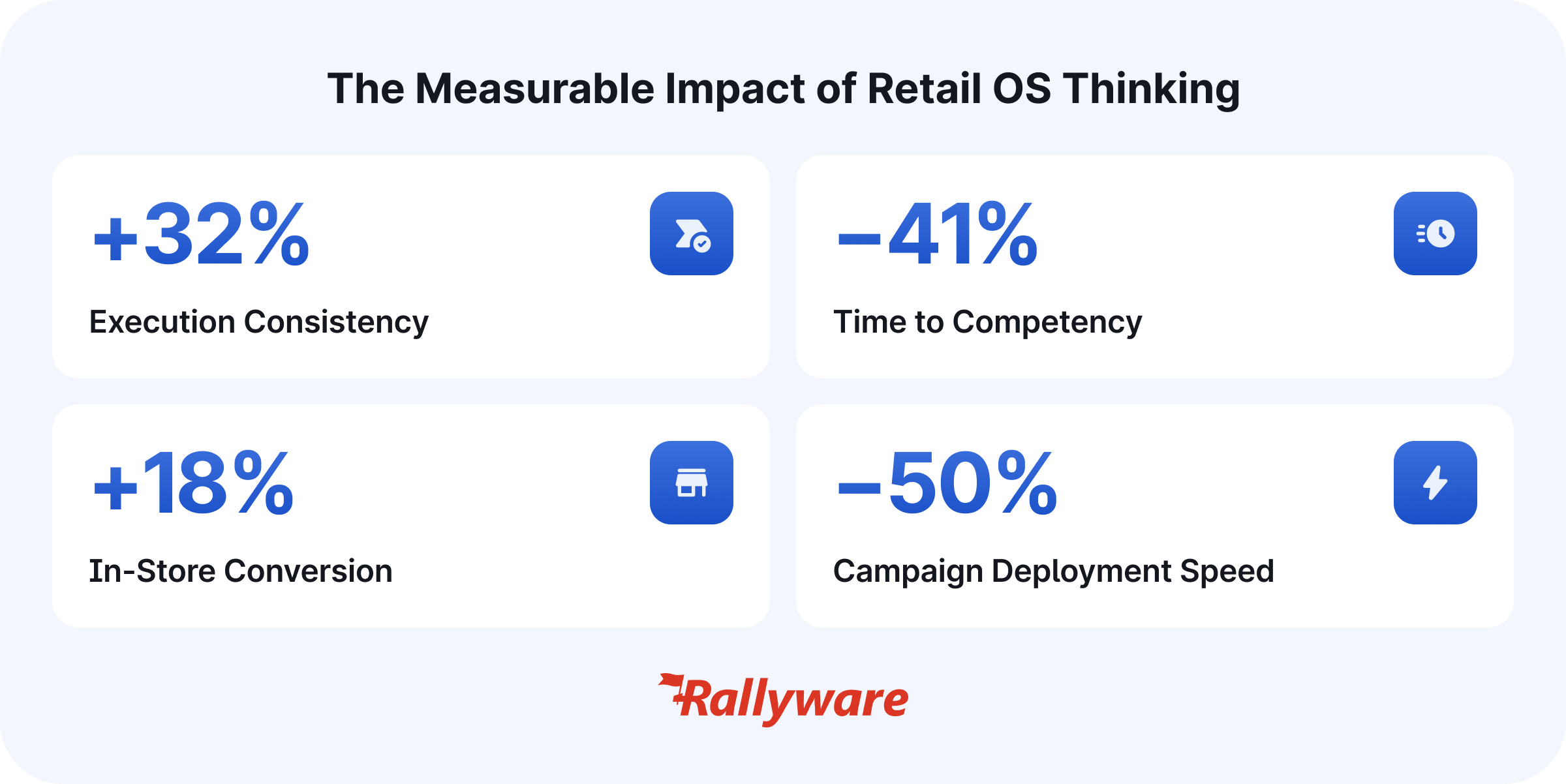Economic News May 2023 and How Performance Enablement Protects Against Downturns
Retail OS: The new backbone of store execution
Retailers are leaking 10 to 15 percent in-store conversion because their systems tell them what’s happening, not what to do. Associates are guessing. Training is disconnected. Execution gaps stay hidden until it’s too late.
As digital channels run on real-time optimization, physical retail continues to rely on delayed dashboards and siloed tools. That gap between data visibility and execution intelligence is the last major unlock for modern retail performance.
A retail operating system, or Retail OS, is to physical retail what a CRM is to digital commerce. It is not another dashboard or app. It is a unified intelligence layer that drives execution, not just insight.
Why retail execution systems must evolve now
Despite years of digital transformation, 83.8 percent of total retail revenue in North America still happens in stores, according to MIT Sloan. The physical store remains the economic engine, but it runs on outdated systems designed for reporting, not real-time action.
Online platforms have moved far beyond visibility. They deliver personalized recommendations, live A/B testing, and predictive nudges that optimize every click. In stores, associates are often left with paper checklists, outdated learning systems, and static communication tools.
The result is missed opportunities, inconsistent experiences, and underperforming campaigns. These problems come not from lack of effort but from lack of orchestration.
A Retail OS changes that by operationalizing intelligence, turning data into guided, measurable, on-floor execution.
The strategic contrast: From reporting to orchestration
Traditional retail tools focus on what happened. A Retail OS focuses on what should happen next.
This shift is strategic, not technical. Retailers spent the last decade digitizing marketing and e-commerce. The next decade will be defined by digitizing store execution and associate performance.
Where dashboards stop at insight, a Retail OS goes further. It activates tasks, learning, and incentives based on real-time store conditions. It closes the loop between headquarters strategy and frontline execution, at scale and in the moment.
That is the real transformation, moving from command and control to orchestrate and enable.
The rise of frontline enablement platforms
At NRF 2025, “empowered frontline” was one of the most discussed trends. Leading retailers are realizing that insight without action is a dead end.
Retail superapps are evolving into execution engines. These systems unify tasking, training, communications and incentives into one intelligent flow, orchestrated by real-time data.
Leaders adopting Retail OS platforms such as Rallyware are already seeing measurable results: faster campaign rollouts, higher associate sales productivity, and a new standard of in-store excellence.
This is more than technology evolution. It represents a new operating model for the physical store.
In 2025, Old Navy partnered with RADAR to roll out RFID and computer vision across its store fleet. Real-time, item-level visibility unlocked operational efficiency, but the bigger breakthrough came when associates began acting differently.
With instant access to product data and restocking insights, associates shifted from reactive to proactive engagement. The technology did not just locate items; it elevated human performance.
Now layer in Retail OS capabilities, and that intelligence turns into live guidance:
Product prompt: “CloudTec cushioning, ideal for runners. Ask about surface preference.”
Upsell cue: “Recommend CloudTec insoles, $29.99 add-on.”
Objection assist: “800-mile durability, best cost-per-mile in category.”
Cross-sell nudge: “Socks aisle B-7. Waterproof version, size 9, two in stock.”
This is contextual enablement — AI-informed, data-driven, and human-delivered.
What a Retail OS actually does vs. legacy systems

A Retail OS is not a single product. It is an ecosystem, an operational intelligence layer that connects existing tools such as POS, WFM, LMS, inventory, and communication systems into a unified associate experience.
It bridges the gap between strategy and execution, enabling real-time guidance that drives measurable business outcomes. Every moment becomes a micro-optimization opportunity, just like digital commerce, but in the physical store.
Why Retail OS thinking is winning
Retailers adopting Retail OS architectures report measurable impact:

That is the difference between visibility and velocity.
Execution is not a training problem. It is an orchestration problem.
Traditional systems push content and hope for behavior change. A Retail OS activates action. It connects data, people and process into a single operational rhythm where strategy, communication, and performance reinforce each other in real time.
For executives, this reframes the conversation. A Retail OS is not another point solution. It is the connective tissue of modern retail operations.
The cost of inaction
Every quarter without Retail OS capability compounds operational drag:
- Lost conversion from missed customer moments.
- Campaign breakdowns at the shelf level.
- Associate churn due to a lack of clarity and recognition.
- Wasted labor on low-priority tasks.
Do those challenges sound familiar? Competitors implementing Retail OS architectures are already pulling ahead, converting data into real-time action and strategy into measurable frontline performance.
The new retail operating model
The next generation of retail growth will come from executional intelligence. Dashboards do not drive change. Orchestration does.
A Retail OS transforms how associates work, how stores perform, and how leaders scale strategy. It is not another layer of software. It is the new infrastructure for intelligent, high-velocity execution.
The question is not if your organization needs a Retail OS; it is how fast you can operationalize it before your competitors do it first.
FAQs: Retail OS essentials
What is a Retail OS?
A unified operating system that connects tasking, training, communication, and incentives into one associate-facing platform powered by real-time operational data.
What integrations are required?
A Retail OS connects with existing POS, WFM, LMS, inventory, and communication systems to orchestrate data-driven actions at scale, while in some cases, it has a number of solutions embedded in its core.
What is the time to value?
Retailers using platforms such as Rallyware report measurable execution uplift within six to eight weeks of pilot deployment.
Which KPIs improve?
Conversion, time to competency, sell-through rate, and store NPS consistently rise as associates execute with data-informed precision.
Who owns the Retail OS initiative?
Typically, retail operations, in close partnership with store operations, merchandising, and IT, with executive sponsorship from the COO or chief experience officer.
The road ahead
Execution is retail’s final frontier for digital transformation.
A Retail OS closes the intelligence gap between knowing and doing, between the HQ and the sales floor, driving performance in real time, at scale, with measurable outcomes.
Retail leaders who invest now will not just optimize store performance. They will redefine what operational excellence looks like in the modern retail era. To understand how leading brands are leveraging retail workforce management software to power their Retail OS strategies, explore our in-depth comparison of the top platforms shaping the future of store performance.
News and Insights on Workforce Training & Engagement
We’re among top-notch eLearning and business engagement platforms recognized for effective training and talent development, helping to empower distributed workforces
Subscribe
